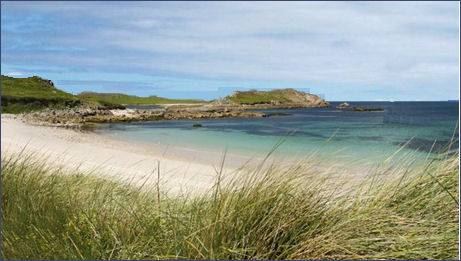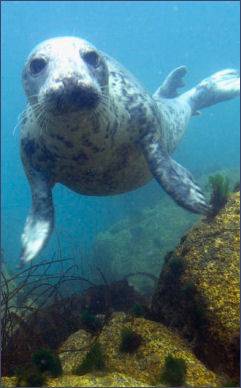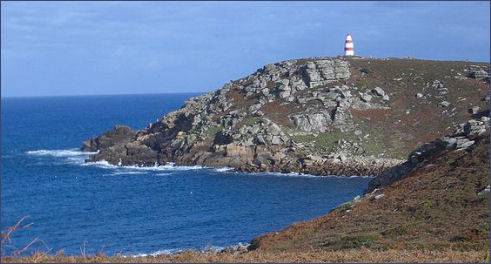St. Martin's
OS grid reference :- SV 924341
 The island of St. Martin's is the northernmost populated island on the Isles of Scilly.
The island of St. Martin's is the northernmost populated island on the Isles of Scilly.
The island has three main settlements, Higher Town, Middle Town and Lower Town which have a resident population of about 120 people. There are quays at Higher Town (the Higher Town Quay, used at high tide) and at Lower Town (the Hotel Quay, used at low tide). A bakery, St. Martins Bakery, is located at Higher Town.
Known in Cornish as Brechiek, meaning "dappled island", St.Martin's is known for its gorse-covered moorland, flower fields and superb white beaches. The island is just two miles long, yet it has some of the finest beaches in the British Isles.
 Watersports and boat trips are available to the Eastern Isles, a group of twelve small uninhabited islands including St Helen's, Nor Nour, Great Ganilly, Great, Middle and Little Arthur, which are home to many bird and seal colonies and the distant sight of Land's End offers a dramatic backdrop to Scilly's most easterly inhabited island. The isles are also home to breeding colonies of eight species of sea bird including three species of gull, as well as the common shag (Phalacrocorax aristotelis), great cormorant (Phalacrocorax carbo), northern fulmar (Fulmarus glacialis), razorbill (Alca torda) and puffin (Fratercula arctica). The Isles have a long period of occupation from the Bronze Age with cairns and entrance graves through to Iron Age field systems and a Roman shrine on Nornour
Watersports and boat trips are available to the Eastern Isles, a group of twelve small uninhabited islands including St Helen's, Nor Nour, Great Ganilly, Great, Middle and Little Arthur, which are home to many bird and seal colonies and the distant sight of Land's End offers a dramatic backdrop to Scilly's most easterly inhabited island. The isles are also home to breeding colonies of eight species of sea bird including three species of gull, as well as the common shag (Phalacrocorax aristotelis), great cormorant (Phalacrocorax carbo), northern fulmar (Fulmarus glacialis), razorbill (Alca torda) and puffin (Fratercula arctica). The Isles have a long period of occupation from the Bronze Age with cairns and entrance graves through to Iron Age field systems and a Roman shrine on Nornour
 To the north, St Martin's is joined by a tidal causeway to the uninhabited White Island, designated as a SSSI due to its waved maritime heath, maritime grassland, breeding seabirds.
To the north, St Martin's is joined by a tidal causeway to the uninhabited White Island, designated as a SSSI due to its waved maritime heath, maritime grassland, breeding seabirds.
At the northeast corner of the island is a large red and white daymark (pictured right). Said to be the earliest surviving example of a beacon in the British Isles, it was erected in 1683 by Thomas Ekins, the first steward of the Godophin Family to live on the islands.
The Daymark is a rendered granite circular tower 4.8 metres (16 ft) in diameter and 6.4 metres (21 feet)in height, set back to conical termination making it 11 metres (36 ft) high. The blocked arched entrance door contains an incorrect date of 1637. It was painted white until 1822 but by 1833 had been painted red, and is now painted in bands of red and white.
Chuchtown Flower Farm is open to the public, free of charge and offers the chance to view their busy packing sheds and order local flower gifts. While at St. Martins Vineyard, the most south-westerly vineyard in England, established in 1996 on south facing slopes overlooking the Eastern Isles of Highertown Bay, visitors can take tours of the vinyard and sample white, red and rose wines.
There is also a diving school on St. Martin which offers underwater adventures and snorkelling with seals. The waters around Scilly are renowned for their many wrecks and stunning marine life. The St Martin's Dive School is a BSAC Premier Dive School and can provide diving opportunities for all levels of experience.
| Bryher Island | Eastern Islands | Gugh Island | Nornour Island |
| St. Agnes | St. Helen's | St. Martins | St. Mary's |
| Tresco |